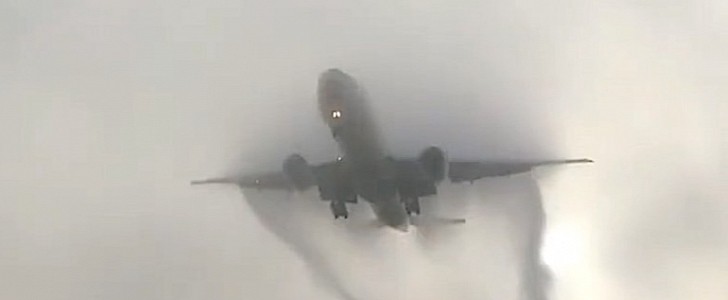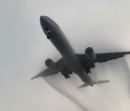Airplanes are such extraordinary machines that scores of people have dedicated their lives to stalking these winged metal beasts. It is thanks to these people, who we generally call plane spotters, that we get incredible instances of airborne machines in action.
Today’s aircraft stunt treat is a bit of a mystery. It comes in the form of a short video, published this week by a specialized Twitter account, with zero information about when or where it was shot. That means we may be dealing with an older clip, but regardless of that, what we get to see in there is so amazing it’s worth a short piece here on autoevolution.
Judging by the lanes vehicles seen in the clip use to travel on, as well as the color of the license plates, this probably happened somewhere in the UK. The clip opens with a shot of the overcast sky, and a bulging patch of cloud, shining a bright light somewhere deep inside.
The bulge quickly morphs into a streak of sorts, with a massive Boeing 777 at its center, and a shroud of water vapor engulfing it on all sides. Pushed by the hulk of metal moving under the power of two massive engines, the clouds eventually move out of the way for all the aircraft to land in full view.
You can enjoy the entire birth of the Triple Seven from clouds in the tweet attached below. Before you move along, though, a short reminder of what this airplane is all about.
The breed was born in 1994 as a long-range widebody airliner, and it’s presently offered to operators in two variants, 777-200LR and 777-300ER. What sets them apart is size (ER is larger and can seat 396 people as opposed to 317) and range, with the LR taking the lead with the ability to cover 9,844 miles (15,843 km), as opposed to 8,481 miles (13,649 km).
The family also has the 777x in the pipeline, with a scheduled introduction as the world’s largest and most efficient twin-engine jet set for 2024.
Judging by the lanes vehicles seen in the clip use to travel on, as well as the color of the license plates, this probably happened somewhere in the UK. The clip opens with a shot of the overcast sky, and a bulging patch of cloud, shining a bright light somewhere deep inside.
The bulge quickly morphs into a streak of sorts, with a massive Boeing 777 at its center, and a shroud of water vapor engulfing it on all sides. Pushed by the hulk of metal moving under the power of two massive engines, the clouds eventually move out of the way for all the aircraft to land in full view.
You can enjoy the entire birth of the Triple Seven from clouds in the tweet attached below. Before you move along, though, a short reminder of what this airplane is all about.
The breed was born in 1994 as a long-range widebody airliner, and it’s presently offered to operators in two variants, 777-200LR and 777-300ER. What sets them apart is size (ER is larger and can seat 396 people as opposed to 317) and range, with the LR taking the lead with the ability to cover 9,844 miles (15,843 km), as opposed to 8,481 miles (13,649 km).
The family also has the 777x in the pipeline, with a scheduled introduction as the world’s largest and most efficient twin-engine jet set for 2024.
So majestic ???#B777
— Aviation ?? (@ilove_aviation) September 20, 2022
???? - Speedbirduk pic.twitter.com/SxoXz0Rj3u







